White Coat Veterans Gather for 35th Anniversary Celebration
By Mark Ford
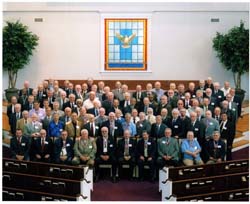
Medical history came to Frederick, Md., with the 35th anniversary celebrating the end of Project White Coat. Despite Hurricane Ike—which brought torrential rains, tornadoes, flooding and power outages to Mid-America—98 White Coat veterans and their families from 26 states recently gathered at Chesapeake Conference’s Frederick church to remember and honor the service of more than 2,300 fellow Adventist members who volunteered to be human test subjects in the heated days of the Cold War.
They also came to express thanks to Fort Detrick, now known as the U.S. Army Medical Research Institute for Infectious Diseases (USAMRIID), and the researchers who managed the program, and to receive proclamations from President Bush and Maryland Governor Martin O’Malley.
During the business session Saturday evening, Washington state’s George Ulloa was elected as the new White Coat Foundation president, together with a new board of directors.
For most of the veterans, it was a chance to re-connect with old friends and reminisce. “I was the first one, of three, to put our nose in the eight-ball,” said Ken Jones who traveled from Riverside, Calif., to be on hand. “We breathed in the Q-fever germ, January 25, 1955. I did not get sick, none of us did. But the next three did.”
Veterans continued to arrive throughout the weekend. “We know of at least 36 who couldn’t come because of the damage from Hurricane Ike,” said Frank Damazo, MD, one of the organizers of the weekend event, a long-time White Coat promoter, and a Frederick church member. Even so, the sanctuary was filled Saturday morning.
“This is really very much an honor to be in the same room with these gentlemen,” said Mayor Jeff Holtzinger, who presented a letter from Governor Martin O’Malley commending the veterans. “It demonstrates the importance of the research that's been done and the service that these gentlemen gave in order to come to something that was a very real threat.”
A primary purpose of the White Coat program was to test the effectiveness of various methods used to disperse biological agents, and to develop countermeasures and treatments that could protect both soldiers and citizens in the event of an attack.
“Project White Coat predated USAMRIID but it had the same mission so far as developing countermeasures,” said Col. John Skvorak, commander of USAMRIID. “We learned a lot about these diseases, their signs and symptoms, and treatments. They've helped us develop many of the processes and procedures and equipment that we use for safety, which is incredibly important.”
“We hear a lot about patriotism as the election season is upon us,” said Col. Judith Robinson, commander of the U.S. Army Garrison at Fort Detrick, “but it is important that we remember this group of folks who were not only able to serve their country in time of war and great need, but also to stand firm in their beliefs and to make great sacrifices; to put themselves in harm's way to the betterment of not just this country, but for all humanity.”
Rep. Roscoe Bartlett presented the veterans with a letter of commendation from President George Bush, which lauded the men for their courageous stand. “We are honoring these veterans who served as sort of guinea pigs in the biological warfare program that we were once very much involved in,” said Bartlett, also a member of the Frederick church, before the morning service. “We meet frequently, but there are fewer and fewer each time because it was a long time ago.”
In For God and Country, author Robert Mole writes that White Coat volunteers were drawn almost exclusively from Seventh-day Adventist draftees who, as registered conscientious objectors, were stationed at Fort Sam Houston in San Antonio, Texas, to be trained as medics. When the White Coat project started in 1955, the volunteers were transferred to Fort Detrick, where the precursor of today’s USAMRIID was based. The program continued through 1973. In that time a total of 153 research projects were conducted.
“I was drafted six months after I joined the church,” remembers Pastor Jack Calkins of Potomac Conference’s Patterson Avenue church in Richmond, Va., who served from 1969 to 1971. “I thought it was a dirty trick, but it turned out to be an incredible blessing.”
The names of 104 White Coat veterans who have died was read to the assembly, and taps was played as veterans stood in honor of their memory. “I received word today of two more who have passed away,” said Dr. Damazo, who was made an honorary White Coat veteran for his efforts on their behalf. “This is the last anniversary gathering that I will help organize. Someone else will have to take it up now,” he said. The first reunion was celebrated at the Frederick church in 1985.
Other groups are active in San Antonio and in Washington state. For information on the White Coat Foundation, contact George Ulloa at gulloa@hotmail.com or (360) 687-3244.
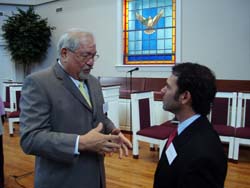
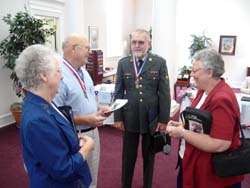
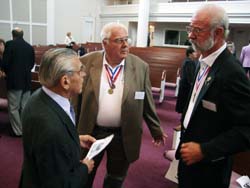
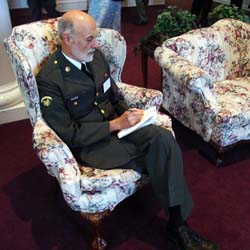
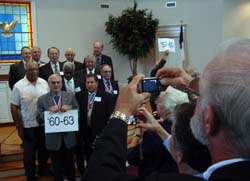

Add new comment